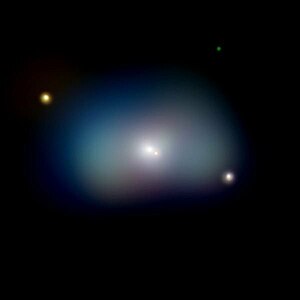NGC 1700
| Galaxy NGC 1700 |
|
|---|---|

|
|
| Chandra X-ray image of NGC 1700 | |
| AladinLite | |
| Constellation | Eridanus |
|
Position equinox : J2000.0 , epoch : J2000.0 |
|
| Right ascension | 04 h 56 m 56.313 s |
| declination | -04 ° 51 ′ 56.79 ″ |
| Appearance | |
| Morphological type | E4 |
| Brightness (visual) | 11.2 mag |
| Brightness (B-band) | 12.2 mag |
| Angular expansion | 3.3 ′ × 2.1 ′ |
| Position angle | 120 ° |
| Surface brightness | 13.4 mag / arcmin² |
| Physical data | |
| Affiliation | NGC-1700 group LGG 123 |
| Redshift | 0.012972 ± 0.000023 |
| Radial velocity | (3889 ± 7) km / s |
|
Stroke distance v rad / H 0 |
(170 ± 12) · 10 6 ly (52.0 ± 3.6) Mpc |
| history | |
| discovery | Wilhelm Herschel |
| Discovery date | October 5, 1785 |
| Catalog names | |
| NGC 1700 • PGC 16386 • MCG -01-13-038 • 2MASX J04565634-0451566 • GC 932 • H IV 32 • h 336 • LDCE 351 NED016 • WISEA J045656.30-045156.6 | |
NGC 1700 is an elliptical galaxy of Hubble type E4 in the constellation Eridanus at the southern sky . It is around 170 million light-years away from the Milky Way and has a diameter of around 170,000 light-years . Presumably it forms a gravitationally bound galaxy pair with NGC 1699 . Together with NGC 1729 , NGC 1741 , IC 399 , IC 2102 , PGC 16570 and PGC 16573 , it is considered a member of the NGC 1700 group ( LGG 123 ).
The object was discovered by Wilhelm Herschel on October 5, 1785 .
NGC 1700 group ( LGG 123 )
| Galaxy | Alternative name | Distance / million ly |
|---|---|---|
| NGC 1700 | PGC 16386 | 170 |
| NGC 1729 | PGC 16529 | 158 |
| NGC 1741 | PGC 16574 | 176 |
| IC 399 | PGC 16582 | 174 |
| IC 2102 | PGC 16197 | 158 |
| PGC 16570 | 181 | |
| PGC 16573 | 175 |
Web links
Commons : NGC 1700 - collection of images, videos, and audio files
